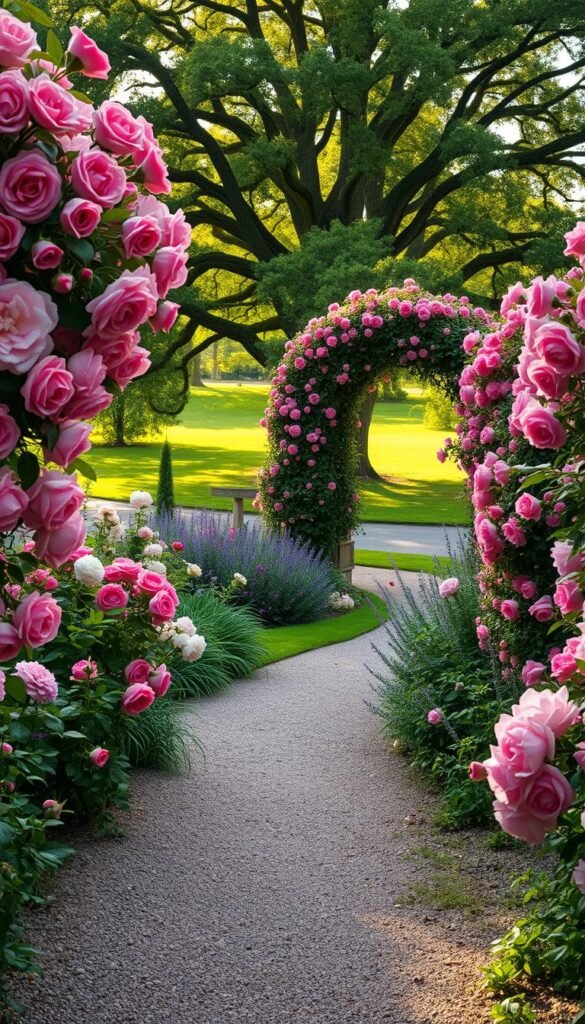Imagine stepping into an outdoor space that feels like a living storybook. Soft petals brush against weathered stone paths, while bursts of color frame every turn. This is the magic of a timeless landscape style that blends structure with wild beauty—a design approach that works whether you’re cultivating acres or a modest patio.
You’ll learn how to mix formal elements like crisp hedges with loose, billowing flowers. Discover the art of creating “garden rooms” that invite exploration, using winding walkways to connect hidden seating areas or tranquil water features. Even small spaces can feel expansive when layered with textures—think feathery ferns beside velvety foliage.
This approach isn’t just about looks. By staggering bloom times and including native plants, you’ll support local wildlife while enjoying ever-changing vistas. Vintage touches—like a repurposed bench or weathered planter—add character, much like the cottagecore charm that celebrates simplicity and nostalgia.
We’ll guide you through balancing practicality with romance. Whether you crave fragrant lavender borders or a shaded retreat under climbing roses, these principles adapt to your climate and schedule. Ready to craft a sanctuary that grows lovelier with each season? Let’s begin.
Introduction to the Timeless Charm of English Gardens
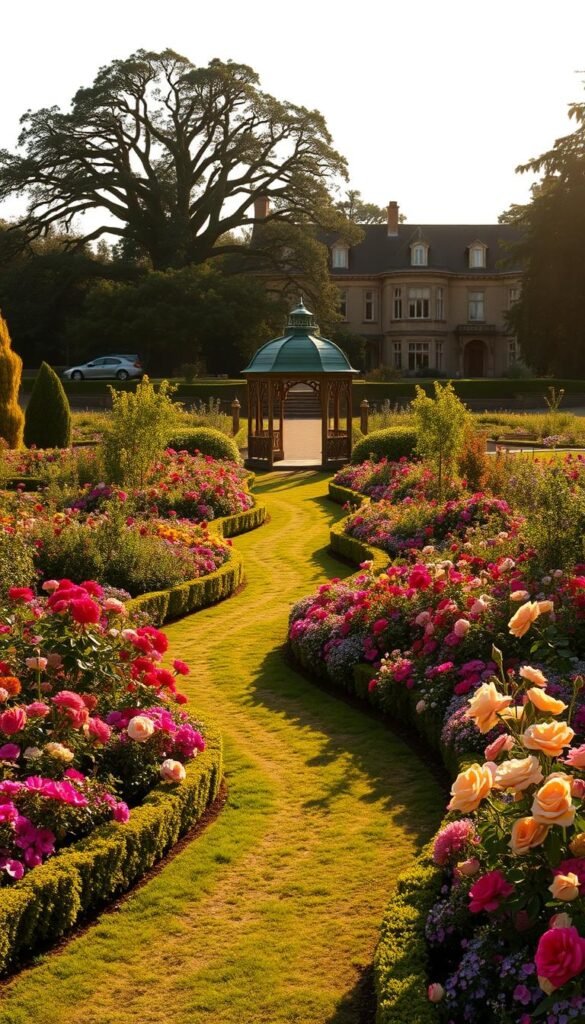
Picture a landscape where history whispers through every hedge and bloom. What began as status symbols for 17th-century aristocrats now inspires homeowners worldwide. These spaces masterfully blend human creativity with nature’s spontaneity—a recipe that transcends time and trends.
Discovering the Roots of Luxurious Landscapes
Early European estates showcased wealth through geometric precision. Think mile-long alleys of yew trees and marble fountains—designs meant to impress, not comfort. Over centuries, designers softened rigid lines with overflowing flower beds and winding gravel paths. This shift birthed the balanced beauty we love today.
Why This Style Fits Any Setting
Modern interpretations keep the soul of historic gardens while ditching impractical scale. A tiny balcony can host potted roses beside boxwood spheres. Urban yards gain depth through layered planting. The magic lies in mixing structure (like crisp edging) with carefree blooms that nod in the breeze.
| Feature | Historical Use | Modern Adaptation |
|---|---|---|
| Pathways | Straight gravel drives | Curving stepping stones |
| Hedges | 10-foot-tall walls | Waist-height borders |
| Flower Beds | Single-color displays | Mixed cottage varieties |
| Focal Points | Oversized statues | Vintage birdbaths |
This design philosophy thrives because it answers our craving for both order and wonder. Whether you’re framing a front walk or creating a private retreat, these principles help craft spaces that feel intentionally wild.
Exploring the Heritage and Modern Adaptations of English Gardens
What if you could merge the grandeur of historic estates with the charm of rural plots? Today’s most inviting spaces often borrow from both worlds—structured elegance meets casual abundance. Let’s unpack how centuries-old ideas shape today’s adaptable design solutions.
From Grandeur to Grounded Beauty
Historic estate gardens prioritized symmetry and spectacle, while cottage plots mixed edibles with flowers for survival. The magic happens when you blend these philosophies. Imagine crisp boxwood borders framing a riot of lavender and sage—order and whimsy in harmony.
Mixing Old-Soul Charm with Today’s Needs
Modern takes keep the soul of both styles. Try espaliered fruit trees against a fence—a formal technique with delicious rewards. Repurpose materials like reclaimed bricks for paths, pairing them with self-watering planters. It’s about honoring tradition without sacrificing convenience.
“The best designs honor history while embracing today’s needs,” notes landscape designer Clara Bennett.
| Element | Estate Style | Cottage Approach | Modern Blend |
|---|---|---|---|
| Walls | Imposing stone | Low picket fences | Stacked slate with wire trellis |
| Planting | Single-color beds | Chaotic mixes | Themed color zones |
| Function | Display only | Food production | Ornamental edibles |
See how rosemary serves as fragrant ground cover? Or how dwarf fruit trees add structure to flower beds? These smart fusions create spaces that delight the senses while respecting your time. The key lies in choosing elements that serve multiple purposes—beauty, utility, and ease.
Planning Your Outdoor Space for an Inviting Garden
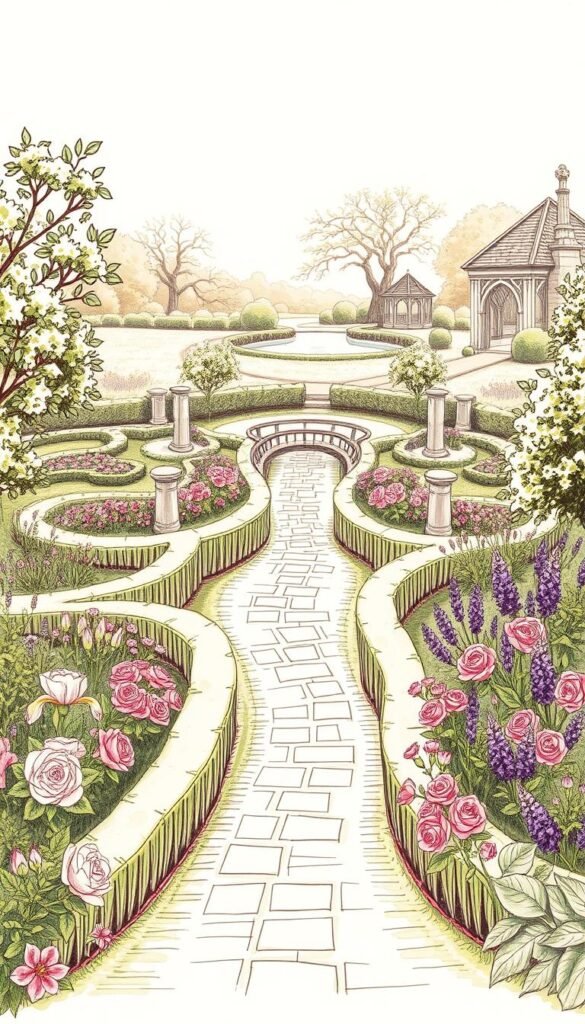
What if your backyard could become a canvas for natural artistry? Start by understanding your plot’s unique personality. Watch how sunlight dances across your outdoor space throughout the day—most flowering favorites need 6-8 hours of direct sun. Grab a notebook and track shadows cast by trees or structures.
Assessing Your Yard’s Potential and Sunlight Exposure
Test soil drainage by digging a 12-inch hole and filling it with water. If it drains slower than an inch per hour, consider raised beds. For inspiration, explore expert tips on adapting classic styles to modern yards.
Sketching a Design that Reflects Your Vision
Start rough—trace your property lines on grid paper, marking existing features. Use curved lines for paths to create flow. Local botanical gardens offer fresh ideas, or browse creative layouts online.
Break your plan into phases. Maybe year one establishes hedges, year two adds flowering shrubs. This approach lets you adjust as plants mature while keeping the design cohesive. Remember: even small areas feel intentional when layered with textures and heights.
Essential Elements of an Authentic English Garden
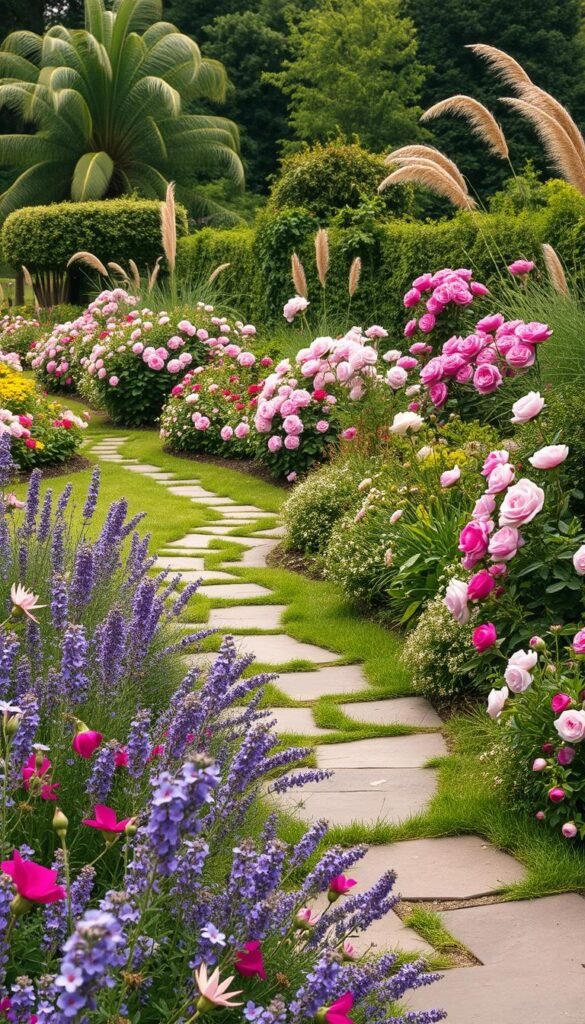
What makes a landscape feel both wild and intentional? The secret lies in combining living architecture with nature’s spontaneity. Start by building your plant foundation—elements that work through every season while creating depth and movement.
Incorporating Classic Perennials and Shrubs
Think of shrubs as your garden’s “bones”—they anchor spaces with shape and texture. Pair spirea’s arching branches with peonies’ lush blooms for spring drama. Summer brings foxgloves towering over catmint’s silvery foliage. This layered approach ensures something always catches the eye.
For continuous color, mix early bloomers like columbine with late stars like asters. Many varieties thrive across climate zones. Try these combinations:
- Delphiniums (zones 3-7) with daylilies
- Hollyhocks (zones 4-8) paired with lavender
- Heuchera’s colorful leaves beneath climbing hydrangea
Using Evergreens and Topiaries for Year-Round Structure
Boxwood spheres frame flower beds even in snow. Yew hedges create living walls that hide utility areas. These elements add polish without feeling stiff—especially when shaped into whimsical cones or spirals.
| Evergreen Type | Classic Use | Modern Twist |
|---|---|---|
| Boxwood | Formal parterres | Potted topiaries |
| Holly | Holiday decor | Variegated screens |
| Juniper | Ground cover | Espaliered art |
Remember: evergreens thrive when matched to your region’s soil. Dwarf varieties suit small spaces, while native species need less care. Your garden becomes a living tapestry that evolves yet always feels complete.
English Garden Aesthetic: Classic Perennials, Roses, and Meandering Pathways
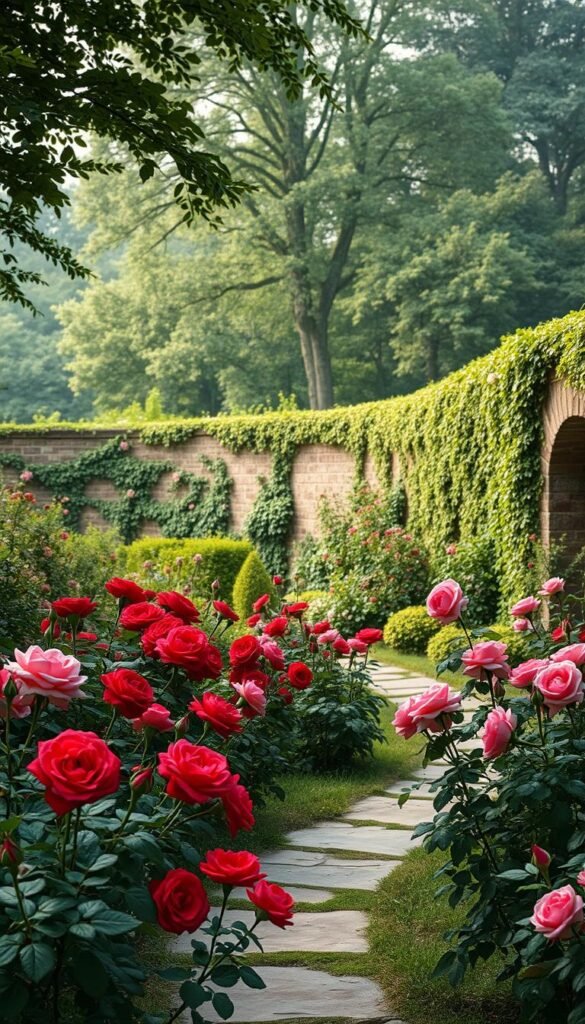
Roses transform ordinary spaces into living poetry. Their velvety petals and heady scents create instant romance, whether cascading over arches or framing stone pathways. Start by selecting varieties that thrive in your climate while offering disease resistance—this lets you enjoy beauty without constant upkeep.
Low-maintenance options like Oso Easy® and Knock Out® roses deliver nonstop blooms from spring through frost. Pair shrub types with ground cover varieties for layered color. Climbers like ‘New Dawn’ add vertical drama when trained on trellises—their canes will gracefully arch over time.
Curving paths invite discovery. Use irregular flagstones or reclaimed bricks for organic charm. Leave small gaps between pavers for creeping thyme or moss to soften edges. This approach guides visitors while creating hidden nooks perfect for benches or birdbaths.
- Fragrant stars: David Austin’s ‘Gertrude Jekyll’ (zones 5-9)
- Disease-resistant: Flower Carpet® Pink (zones 4-11)
- Space-saving: Drift® Roses for containers
Time your planting for continuous fragrance. Early bloomers like ‘Zephirine Drouhin’ give way to repeat-flowering climbers. Underplant with lavender or catmint to amplify scent and deter pests naturally. Your space becomes a sensory journey that evolves daily.
Designing Formal Pathways and Intimate Garden Rooms
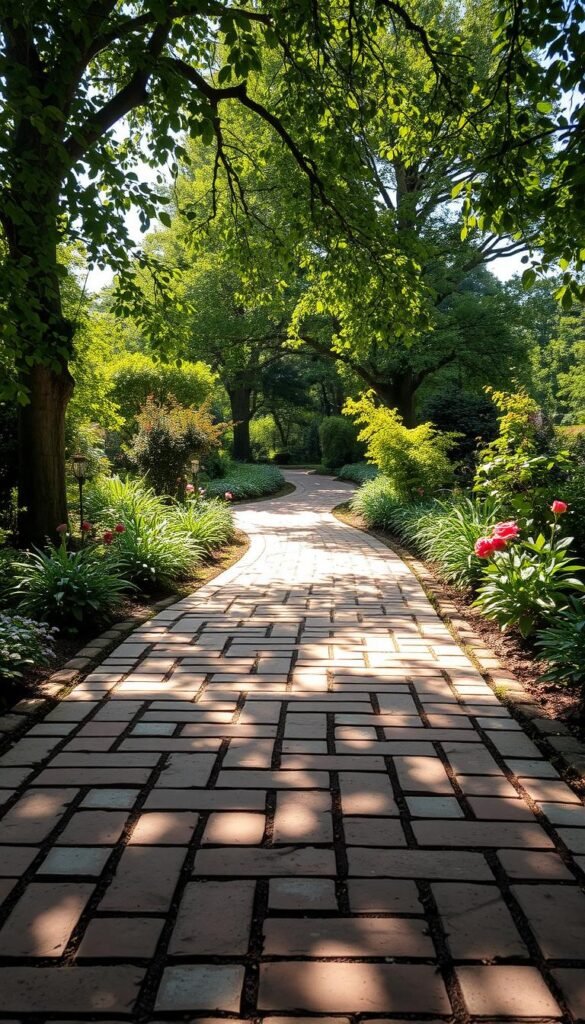
What if your backyard unfolded like a series of secret chambers? By dividing your space into purposeful rooms, you create moments of surprise while maximizing every square foot. Let’s explore how thoughtful layouts and materials turn ordinary yards into curated experiences.
Creating Meandering Stone and Brick Paths
Curved walkways slow the pace, inviting visitors to savor each view. For timeless appeal, try irregular stone slabs with creeping thyme between cracks. Reclaimed brick offers warmth and pairs beautifully with lavender borders. Need drainage? Permeable gravel paths let rainwater seep through while defining routes.
Defining Distinct Garden Rooms with Hedges and Fences
Waist-height boxwood borders carve out dining nooks without blocking sightlines. For privacy, mix evergreen screens with lattice panels supporting clematis. Low walls built from stacked slate double as seating—perfect for hidden reading corners.
| Material | Function | Style Tip |
|---|---|---|
| Brick | Pathways | Herringbone pattern |
| Privet hedge | Room divider | Trimmed arches |
| Wrought iron | Gate accents | Rustic patina |
Balance open lawns with enclosed rooms to spark curiosity. A gravel fire pit area might lead to a rose-framed bench, each space flowing naturally yet feeling distinct. Your landscape becomes a journey where every turn reveals new delights.
Introducing Water Features and Striking Focal Points
Have you ever noticed how water transforms a space? The gentle trickle of a fountain or the mirror-like surface of a pond adds movement and depth to your landscape. Pair these elements with artful accents, and you create moments of wonder that engage both eyes and ears.
Enhancing Your Space With Fountains or Ponds
Water features range from grand stone cascades to humble ceramic bowls. Tiered fountains make bold statements in open areas, while recirculating tabletop models bring serenity to patios. For natural charm, consider a pebble-lined rill guiding water between flower beds.
Small spaces shine with self-contained options like birdbaths or bubbling urns. These compact choices deliver soothing sounds without demanding constant upkeep. Always match the scale to your yard—a 3-foot pond suits urban plots better than sprawling streams.
Selecting the Perfect Garden Statues or Urns
Focal points anchor your design while reflecting personal style. Classic stone statues—think weathered cherubs or graceful herons—add timeless interest. Modern gardeners often mix materials, pairing concrete planters with polished metal spheres that catch sunlight.
Placement matters most. Position pieces where paths bend or seating areas end to guide exploration. A moss-covered urn bursting with trailing ivy becomes a destination, not just decoration.
| Feature Type | Traditional Choice | Modern Twist |
|---|---|---|
| Water Source | Multi-tier fountain | Solar-powered bubbler |
| Sculpture | Greek goddess statue | Abstract steel sculpture |
| Planter | Ornate concrete urn | Recycled trough garden |
Pro tip: Use water to amplify other elements. The reflection of a favorite statue in a pond doubles its visual impact. Together, these features create layers of sensory delight that make your space unforgettable.
Integrating Climbing Roses and Vertical Garden Structures
Elevate your outdoor space by reaching upward. Vertical elements add layers of texture while maximizing small areas. They create visual drama and practical growing space, blending romance with clever design.
Training Climbers for Effortless Elegance
Climbing roses thrive when guided gently. Secure young canes to arbors or DIY trellises using soft ties. Space stems 12-18 inches apart for airflow—this prevents mildew and encourages blooms. Choose materials like cedar or powder-coated metal for lasting support.
Architectural Accents That Pull Eyes Upward
Pergolas frame seating areas with dappled shade, perfect for rose-covered ceilings. Decorative gates wrapped in clematis or jasmine mark transitions between spaces. These structures become living art when paired with climbers that shift with the seasons.
Match plants to their supports. Delicate varieties like ‘Cecile Brunner’ roses suit lattice panels, while vigorous growers need sturdier metal arches. Regular pruning keeps growth tidy, ensuring your vertical features remain both functional and breathtaking.

